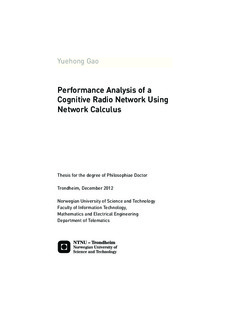| dc.contributor.advisor | Jiang, Yuminig | nb_NO |
| dc.contributor.advisor | Øien, Geir | |
| dc.contributor.author | Gao, Yuehong | nb_NO |
| dc.date.accessioned | 2014-12-19T13:48:16Z | |
| dc.date.accessioned | 2015-12-22T11:47:44Z | |
| dc.date.available | 2014-12-19T13:48:16Z | |
| dc.date.available | 2015-12-22T11:47:44Z | |
| dc.date.created | 2012-12-27 | nb_NO |
| dc.date.issued | 2012 | nb_NO |
| dc.identifier | 580809 | nb_NO |
| dc.identifier.isbn | 978-82-471-4046-8 | nb_NO |
| dc.identifier.isbn | 978-82-471-4047-5 | |
| dc.identifier.uri | http://hdl.handle.net/11250/2370660 | |
| dc.description.abstract | Cognitive radio has become a promising technology to increase spectrum utilization through spectrum sharing between licensed users (primary users) and unlicensed users (secondary users). Performance evaluation and analysis is of key importance to get more knowledge of this newly emerged technology.
Queueing theory and Markov chain model have been applied to conduct the analysis, where some results are obtained. The existing research sheds light on the performance of cognitive radio networks. However, there are also some limitations. Poisson arrival and exponentially distributed service time are mostly assumed in existing analysis. With these assumptions, existing queueing theory results, particularly M/G/1 priority queue results, can be directly applied, and the Markov chain model can be established. However, these assumptions are too restrictive for modern wireless communication networks, where the traffic can be of different types and the channel capacity can vary over time. In addition, particular focus is made on average values (such as average delay) with little investigation on probabilistic distribution bounds.
Therefore, new methodology is needed to make a breakthrough and to bring new insights regarding performance of cognitive radio networks. Network calculus, a newly developed theory, provides a possible solution. It was firstly proposed by R. L. Cruz in 1991, and has involuted into two branches now, i.e., deterministic network calculus and stochastic network calculus. There are two basic concepts in network calculus: (stochastic) arrival curve and (stochastic) service curve, which are used to describe the arrival process of input traffic and the service process of server, respectively. Probabilistic performance guarantees can be analyzed using stochastic network calculus. In addition, the independence between arrival process and service process can be exploited to obtain tighter probabilistic bounds, which is called as independent case analysis.
This work is devoted to applying network calculus analysis, particularly stochastic network calculus, to performance evaluation of a cognitive radio network. Generally, this work contains two scenarios: a single-channel scenario and a multiple-channel scenario.
In the single-channel scenario, several key factors are considered and discussed. Different traffic models, including Periodical source and (Compound) Poisson source, are considered. The sensing error process, which can be further divided into mis-detection process and false alarm process, is modeled, and the corresponding stochastic arrival process is analyzed. Both constant channel and Gilbert-Elliott ON-OFF fading channel are investigated, and the stochastic service curves are obtained. In addition, the influence of different re-transmission schemes is also studied. These schemes include no-re-transmission, re-transmission until success and maximum-Ntime re-transmission. Probabilistic delay distribution bound and probabilistic backlog distribution bound are obtained and discussed. Furthermore, delay-constrained capacity is defined and capacity regions for both primary users and secondary users are also studied. Independent case analysis is applied in some cases, and results are compared and discussed. In the multiple-channel scenario, the main concern is put on the guaranteed service of multiple parallel channels and delay-constrained capacity by assuming perfect sensing and constant channel.
In validating the theoretical results, system configurations are specified mainly based on Long Term Evolution (LTE) networks, and numerical calculations executed in Matlab are made to visually depict the results. Simulation platform by C++ language is also constructed to obtain simulation results. Related results show the influence of different schemes or parameters on system performance and capacity region. Comparison between the numerical and simulation results is made, which further verifies the theoretical deductions. | nb_NO |
| dc.language | eng | nb_NO |
| dc.publisher | NTNU | nb_NO |
| dc.relation.ispartofseries | Doktoravhandlinger ved NTNU, 1503-8181; 2012:358 | nb_NO |
| dc.relation.haspart | Gao, Yuehong; Jiang, Yuming. Chapter 4 Spectrum Allocation. Advanced Cognitive Radio Network, 2011. | nb_NO |
| dc.relation.haspart | Gao, Yuehong; Jiang, Yuminig. Performance Analysis for a Cognitive Radio with Imperfect Spectrum Sensing. IEEE Infocom Workshopon Cognitive Wireless Communications and Networking: 1-6, 2010. 10.1109/INFCOMW.2010.5466711. | |
| dc.relation.haspart | Gao, Yuehong; Jiang, Yuminig; Lin, Tao; Zhang, Xin. Performance Bounds for a Cognitive Radio Network with Network Calculus Analysis. , 2010. 10.1109/ICNIDC.2010.5659456. | |
| dc.relation.haspart | Gao, Yuehong; Yang, Jinxing; Zhang, Xin; Jiang, Yuminig. Capacity Limits for a Cognitive Radio Network under Fading Channel. Lecture Notes in Computer Science. (ISSN 0302-9743). 6827: 42-51, 2011. 10.1007/978-3-642-23041-7_5. | |
| dc.relation.haspart | Gao, Yuehong; Jiang, Yuminig. Analysis on the capacity of a cognitive radio network under delay constraints. IEICE transactions on communications. (ISSN 0916-8516). E95-B(4): 1180-1189, 2012. 10.1587/transcom.E95.B.1180. | |
| dc.relation.haspart | Gao, Yuehong; Jiang, Wenting; Jiang, Yuminig. Guaranteed Service and Delay-Constrained Capacity of a Multi-Channel Cognitive Secondary Network. , 2012. | |
| dc.title | Performance Analysis of a Cognitive Radio Network Using Network Calculus | nb_NO |
| dc.type | Doctoral thesis | nb_NO |
| dc.contributor.department | Norges teknisk-naturvitenskapelige universitet, Fakultet for informasjonsteknologi, matematikk og elektroteknikk, Institutt for elektronikk og telekommunikasjon | nb_NO |
| dc.description.degree | PhD i telematikk | nb_NO |
| dc.description.degree | PhD in Telematics | |






